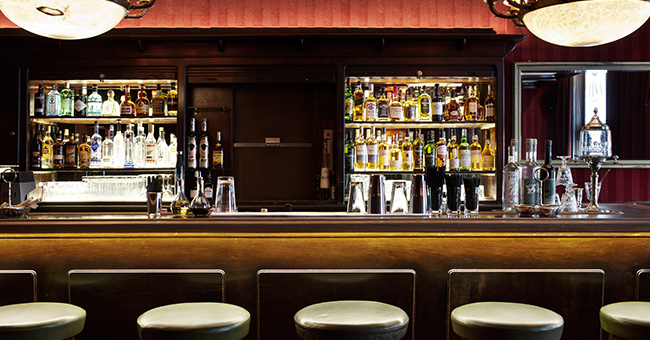Keeping a bar in tip top shape for a perfect health inspection is a challenge. Not only does it require an extensive knowledge of state regulations, but it also necessitates having a team who shares a motivation to keep those standards high no matter what. As we all know, late night closes are difficult and many things can fall through the cracks when you’re hurrying to head home for the night. On top of that, health codes are ever changing, and laws vary from state to state, meaning that staying up-to-date with official guidelines is a job within itself. Even though bartenders are probably as close as it gets, we’re not perfect — we make mistakes. Here are six of the most common oversights that can keep you from acing your next health inspection.
1. Labeling improperly
Labeling is an essential aspect of food safety. Whether storing a housemade syrup, a fresh squeezed juice or freshly made garnishes, every container in your cooler should be labeled with a description of the contents inside of it, as well as the date it was made or, in the case of pre-sealed juices or milk, the date it was first opened. One very simple way to avoid mislabeling is to make sure not to label containers on their lids.
Chris Amato, certified food safety trainer for multiple restaurant groups in the Southeast, explains the importance of labeling containers on the base. “Lids can be easily swapped from one container to another. So whether you’re using that sharpie straight onto the side of your quart container or utilizing the ever-scarce blue tape (which is always recommended) just make sure you’re labeling your bases.”
One type of bottle that often doesn’t get dated as it should is wine. Since wine goes bad fairly quickly even when refrigerated, it should always be dated on the day it is first opened. While there is typically no specific rule about where on the bottle you must date the wine, Amato recommends dating it on the back label, rather than the front in order to keep presentation sharp. “Make sure staff members are dating each opened bottle (immediately, so as not to forget) on the backside of the bottle,” he says. Even if you’re pumping or gassing your wines to keep them fresh, guests will likely be unimpressed to find that their wine is beyond one day old.
2. Incorrectly organizing the coolers
There are very stringent rules surrounding refrigeration and cooler storage that must be followed even behind the bar. Not only must your cooler display thermometers to show they are cooled to the proper temperatures (between 36-45 degrees fahrenheit), but there is also a hierarchy of cooler storage that must be followed to avoid cross-contamination between shelves. In other words, raw or ready-to-eat foods must be kept on the upper-most shelf where nothing potentially harmful could fall onto them.
Behind the bar, this means that uncut citrus fruits, if kept unwrapped, must be stored on the top shelf of the cooler. If your bar keeps whole citrus fruits, cucumbers or apples in a bowl, for instance, that bowl should always be stored on the top shelf of the cooler. Herbs kept in breathable plastic bags, meaning they have holes or slits in them, must also be stored on a top shelf and in a box or bin to avoid direct contact with the rack. Eggs kept in a carton are also a top shelf item.
Foods that will be cooked before consumption, on the other hand, can be kept on lower shelves. For bar coolers, that may mean ginger root for housemade ginger beer or vanilla beans for syrups. The central rule here is to avoid placing a contaminant above a food intended to be eaten without additional cooking.
3. Enabling cross-contamination
Typically we think of cross-contamination as something obvious, like using the same cutting board to prep raw chicken and then cut lemons. But unfortunately, there are many ways that we cross-contaminate our bars all the time without realizing it. It simply comes down to assuring that each individual ingredient is kept separate from anything else. Cutting lemons and limes at the same time without washing your knife and cutting board is considered cross-contamination, for instance. Stirring a drink with a tree nut ingredient without washing the tools in the dishwasher creates a dangerous potential contamination for a guest with a nut allergy.
The New York State Department of Health considers ice a food, and therefore they explain, “ice that will be used in drinks should never be used to chill beer and wine bottles, the outsides of which may be contaminated.” Likewise, items like the hose of the soda gun should never touch the ice, nor should glassware or hands. Burning a well in the middle of a busy shift is one thing bartender’s nightmares are made of, so it’s essential to avoid contaminating the ice with anything.
Many states, including New York, have made it illegal for bartenders to touch ingredients bare handed. “That doesn’t mean that bartenders must wear gloves,” a representative from the NY State DoH qualifies. “They can also use scoops, tongs, picks or other utensils to avoid touching foods.”
 Pro tip: keep everything but floor mats and bus tubs off the ground, and be sure that your glasses are upside down. (Photo: Sheila Sund/Flickr)
Pro tip: keep everything but floor mats and bus tubs off the ground, and be sure that your glasses are upside down. (Photo: Sheila Sund/Flickr)
4. Storing items on the floor
There are only a couple of items that health departments generally allow to be on the ground and they are floor mats and bus tubs (perhaps with a few exceptions from state to state). Since the floor is a petri dish for all kinds of pathogens, this rule is pretty straight forward but can be tricky to navigate when organizing a bar with limited space.
Chemicals are a frequent offender of the ground rule, according to Amato. He advises storing them in a bus tub instead. “That way, if any of the chemicals spill, they’re contained.” CO2 tanks, soda syrup boxes and filled sanitizer buckets are other common items that might get points docked on your next inspection. If you must keep a sani bucket on the ground, stack an empty one upside down below it to create a stand that lifts the sanitizer off of the floor.
5. Handling glassware incorrectly
Stacking glassware can be tricky. Typically, glasses must be stored upside down to prevent dust and other pathogens from contaminating them. Glasses can usually be stacked as long as there is a sheet of paper or mat between each layer, including a breathable bottom layer such as a mat between the glasses and the bar surface. This keeps condensation and mold from building up inside the glass and also prevents pathogens on the bar from getting on the rim. Glasses are also usually allowed to be hung from a rack as long as they are inverted.
Polishing rags are another point of contention for potential contamination. If your bar uses polishing rags, they must be washed daily. Whether using the restaurant’s linens as a polishing tool or specified polishing cloths, they must be properly cleaned in an approved washing and drying facility on a daily basis. Polishing glassware removes lipstick stains and other debris from glasses. Over time, they become wet, removing contaminants which render the rag unhygienic. Oregon health code, in particular, requires that linens and single service items like polishing rags be washed each day, as they are “exposed to splash, dust or other contamination.”
6. Working while sick
The NY State Department of Health says that the worst thing a bartender can do behind the bar is work while under the weather, stating, “a major food safety concern behind the bar is the potential for an ill bartender to infect others. As with other types of food service, bartenders should never work when ill.” As we all know, service staff are typically paid a low hourly wage in addition to tips, which is only guaranteed by our presence at work. We don’t get sick leave or paid sick days. Losing shifts, whether sick or not, means losing money we count on to pay bills.
Until that changes, we can do our best to prepare for unexpected time off, like setting money aside for unexpected time off. Using preventative precautions against illness, including thorough hand washing and glove use during peak sickness seasons, is another way to avoid getting sick.
Often we feel pressured to work while sick for other reasons too. If your team is understaffed, you don’t want to leave them in a lurch on a busy weekend night. There’s a guilt associated with missing work that causes us to come in even when we know we shouldn’t. As a community, it’s important that we work to prioritize self-care as well as the health of our guests.




